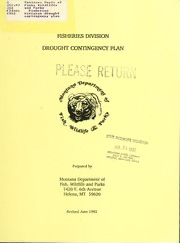
Fisheries Division drought contingency plan PDF
Preview Fisheries Division drought contingency plan
S Montana* Uept* of 351.82 Fisht Wildlife* J62 and Harks F2fddc Fisheries 1992 Uivision drought contingency plan FISHERIES DIVISION DROUGHT CONTINGENCY PLAN O.'Oepa^ ' '^imje <^ STATE Doc *''^^^ ^OLLECTm 'Montana stat Prepared by Montana Department of Fish, Wildlife and Parks 1420 E. 6th Avenue Helena, MT 59620 Revised June 1992 MONTANASTATELIBRARY FSis3h5e1r.i8e2s3D6i2viFs2itocnlddcro1u9g9h2t@coFnWtiPng1e5n-5c7ycp.1 3 0864 00078246 9 TABLE OF CONTENTS Page INTRODUCTION 1 OBJECTIVE I. Protect our Existing Instream Rights 1 OBJECTIVE II. Supplement Streamflows through Purchase ofStored Water, Leasing ofConsumptive Rights, and other Innovative Methods 5 OBJECTIVE III. Obtain Reservoir Operations v^hich Minimize Impacts to Fish, Wildlife and Recreation 6 OBJECTIVE IV Monitor Streamflow, Fish Populations and Fishing Use and . Harvest to Ensure Carry-over ofWild Stream Fisheries while Maintain- ing Reasonable Opportimity for Harvest in all Streams and Lakes. Implement Emergency Regvdations on Streams and Lakes as needed 8 OBJECTIVE V Develop and Implement an Information and Education Program . which Informs the Public and Maintains Consistencyin the Department's Programs 9 OBJECTIVE VI. Coordinate an Updated Department Drought Simimary for Presentation to the Governor's Drought Advisory Committee and/or DisasterAdvisory Council and the Fish, Wildlife and Parks Commission as Required 9 OBJECTIVE VII. Develop and Implement Water Conservation Practices within the Agency 10 . FISHERIES DIVISION DROUGHT CONTINGENCY PLAN INTRODUCTION ThisdocumentpresentsthedroughtcontingencyplanoftheFisheriesDivisionofMontana Department ofFish, Wildlife and Parks (DI^WP). The plan describes actions the Division willtaketoprotectfisheryresources,includingprotectinginstreamflowwaterreservations and rights, securingadditional waterforinstreamflowthrough purchase ofstoredwater, waterleasing, cooperationwith reservoiroperators, and implementing emergencyfishing regulations where appropriate. In addition, the Fisheries Division will monitor fish populations and docviment drought impacts, develop and implement an information and education program which informs the public ofdrought conditions and effects on fishery resources and activelyparticipate on the Governor's Drought Advisory Committee. Theeffectsofdroughtonfisheryresourcesisnotconfinedtothesingleyearofthedrought conditions. Verylowflowscangreatlyreducerecruitmentofayearclassoffishbylimiting spawningandrearinghabitat. Thistypeofimpactmaynotbefeltbyrecreationistsfortwo to four years following the drought when the year class fails to appear in the fishery in significant nimibers. OBJECTIVE L Protect our Existing Instream Rights A. Summary ofExisting Rights to be Protected TheinstreamrightstobeprotectedincludeMurphyRightson12streams,reservations on 66Yellowstone basin streams; AshleyCreek; YoungCreek andTobacco River. In thefuture,theywillalsoincludeanyotherinstreamreservationsgrantedbytheBoard ofNatural Resources and Conservation. B. Protection Procedures The schedule ofdecision points for protecting instream rights is shown in Figure 1 Procedures Narrative Water Supplv Forecasts (SCS)' Montana's yearly water supply outlook is developed by the SCS and its cooperators. Current snowpack and forecasts of runoff are issued each month firom January through ^Items in parenthesis identify responsible parties - 1 - ) Figure 1 IMPLEMENTATION SCHEDULE FOR PROTECTING INSTREAM RIGHTS AND RESERVATIONS SCS Water Supply Forecast (Jan-May) I DROUGHT PREDICTED 1 "^ Obtain current list of junior water users (May 31 1 Send Initial notification letter to junior water users (June 15) I Monitor streamflows/compare with established Instream rights I DROUGHT OCCURS (Flows fall below instream rights) I Send 2nd notification letter to junior water users -- request compliance I Continue monitoring flows and determine compliance 1 Enforcement Action (See text, p. 3) 1(a) May. From these forecasts, it is possible to estimate streamflow conditions during the summer, enabling us to determine ifwe will need to notifyjvmiorwater users about our instream rights and the possibility they mayhave to cease their diversions upon request. List ofJuniorWater Users (Helena) A current list ofalljimior water users is obtained from the Helena water rights office of the Department ofNatviral Resources and Conservation (DNRC) by May 31. Initial Notification Letter (Helena) Ifthewatersupplyoutlookispoor, aninitialletterissenttoeachwateruserwhosewater use priority date isjunior to the priority date established for each ofour instream water rights. The initial letter simply informs those junior users of DFWP's prior right(s) in their source(s) of supply and indicates that we may, if unsuitable flow conditions actually materialize, notifythemata latertime toceasetheirdiversion(s). This letteris signedby the DepartmentDirectorandissentbyregularmail. ThelettershouldbesentbyJune 15 to allowjuniorusers to develop alternatives to the use oftheirjimiorwater. Streamflow Monitoring (Helena/USGS) Streamflows aremonitored atestablished USGSgagingstations. Flowlevels are obtained from the USGS's Helena office on a regular schedule, usually twice a week. These flows are compared to the respective instream water rights and the flow trend is monitored. Monitoring of flows depends on having streamflow data available upon request at appropriatestreamsites. Thesedata canbe obtainedfiromnon-recordinggagesreaddaily by an observer or from continuous recording gages which automatically transfer data to a receiving station. Currently, all streams where we have instream rights do not have gagesinstalledonthem. Wheregagesare notavailableonaparticularstream,weusethe closest downstream gage which will record that stream's flow. Second Notification Letter (Helena) When the actual flow at anygaging station drops to the level ofthe established instream flow for that time of year, a second notification letter is sent to those junior users monitored bythat gage. Theletterrequeststhe users to cease theirdiversion(s), presents gaginginformationandlistsphonenumberstheycancalltokeeptrackoftheflowssothey will know ifthey can again begin diverting water. This letter is ovir"call" for the water. Thisletteris alsosigned bythe Department Directorandis currentiysentbyregularmail. There is no established date onwhich to send this second letter; timing depends on flow conditions in a given year. -2-
